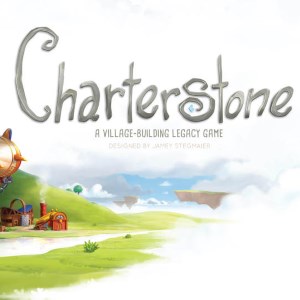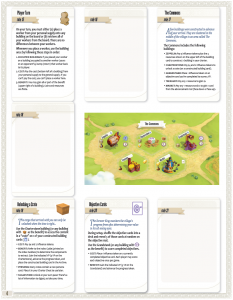
Before playing Charterstone I hadn’t played a legacy game before; that is, a game which evolves and has you permanently changing parts of the game by destroying certain elements, sticking things onto certain components and generally making sure you can’t go back on your decisions. Ever. They’re one-time experiences, games that you can put hours upon hours into, and then never have the option of playing again unless you buy the whole thing. It sounds brutal, and it certainly can be – while I haven’t played the Pandemic Legacy games, I’ve heard more than enough to know how the evolving storylines and characters really start to affect the people playing it.
With that in mind, we cracked open the impressively heavy Charterstone box, and got to work.
The whole experience takes place over 12 games, and getting started is as simple as reading the first few card-sized instructions in the Chronicle. What is immediately obvious is that most of this booklet isn’t filled in, instead giving areas where you’ll be sticking new rules and story segments into preset spaces as the game progresses. When you see just how few of these are already printed, it’s pretty clear just how unique your version of the game is going to end up being. With this being a village building game it doesn’t sound like it would have the same level of excitement when compared to the survival-heavy Pandemic games, and that’s exactly how things pan out, but I’ll come to that later.
The weight of the box is mainly down to the huge number of cards you’ll find hiding beneath the fairly big, and initially fairly plain looking game board. The index box is full of cards that you’ll be picking out throughout the game, and itself houses a huge number of possible future actions that you’ll be taking. Those which become stickers (and therefore can’t be used again) get put into an Archive box which is totally needless during the game itself, but with the Recharge Pack (which you buy separately) letting you replace your defaced cards with brand new ones to let you play all over again it’s handy to know which cards you need to place back into the index. With the Recharge Pack being less than half the price of the base game, it’s a very cool option to have on standby if you want a second run through the campaign.
There are a few other components other than the cards though, with six different resources having their own small markers, as well as some great looking coins that you’ll be using along with the metal, pumpkins and so on. The whole game feels fantastic when handling it, and between the high quality cards and solid components you can tell a lot of effort went into producing Charterstone. There’s some nice artwork too, and while the style lends itself to a less intense game than the Pandemic options, it fits in nicely with the fact that you’re basically trying to make a village for the rather picky Forever King.

Once you’ve followed the first few cards and got the game set up you’ll have already placed a few stickers, had a couple of little surprises and unearthed a few more components that’ll allow you to carry out the worker placement elements of the game, and it’s this worker placement idea that makes this a fairly unusual legacy game. The storylines that unfold are nice enough, but don’t carry as much weight as I’d expected. Instead the focus seemed to be more on the building element, and putting your town together in such a way that’d score you a few more points. You’ll be completing objectives, managing your various resources, trying to find and open chests that grant you several cards at once and leaving you with some very handy things to keep close to you throughout the game. I’m not going to drop specifics, despite the light story there are still plenty of surprises I don’t want to ruin, but if you can afford the coins and resources it’s very much worth keeping an eye out for these extra collectables.
It’s entirely possible to save your game’s progress between chapters, which you’ll probably want to do unless you can spend an entire day playing through the entire campaign. Whether you’ll be able to remember why you’ve made some of the choices will probably depends on how many other games you play between sessions and how long you leave it for, but it’s a well thought out saving mechanism.
Finally, and unusually for a legacy game, once the game is over it’s not actually as final as you might expect. Yes, you’ve got a rulebook which is covered in stickers, and a board which is probably different to every other Charterstone board in existence, but there’s a game waiting for you at the end of it all. I didn’t get chance to try that (in fact I haven’t quite made it to the end of an entire campaign, but we’re getting there) but it’s nice to know that even without paying out for the Recharge Pack you’ve got more gaming ahead once you’re finished.
I’ve surprised myself with how much I liked Charterstone. It always looked like a gorgeous game, but the idea of permanently affecting the components gave me a weird feeling. But it works really nicely, and with the much lighter mechanics (although still complex enough to warrant some learning time) there’s plenty of time to focus on enjoying the development of your buildings and the town as a whole. Don’t go into this expecting the same kind of story telling you’d probably get in Pandemic Legacy and you’ll most likely love it.

Leave a Reply